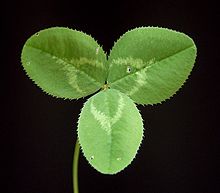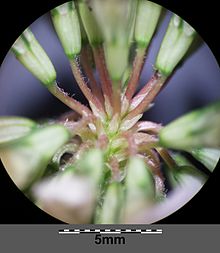White clover
| White clover | ||||||||||||
|---|---|---|---|---|---|---|---|---|---|---|---|---|

White clover ( Trifolium repens ) |
||||||||||||
| Systematics | ||||||||||||
|
||||||||||||
| Scientific name | ||||||||||||
| Trifolium repens | ||||||||||||
| L. |
The white clover ( Trifolium repens ), also Kriechklee called, is a plant that the subfamily of the Pea family (Faboideae) within the family of legumes belongs (Fabaceae or Leguminosae).
description
Appearance and leaf
The white clover is a perennial herbaceous plant and reaches heights of 5 to 20 centimeters. It forms a strong taproot and a branched “ earth stick ”, but no underground runners . The bald, creeping stem becomes 5 to 30, rarely up to 40 centimeters long and forms roots at the nodes . It has roots up to 70 centimeters deep.
All leaves are apparently basal, due to the lying stem axis , arranged and divided into petiole and leaf blade. The petiole is up to 20 centimeters long. The leaf blades are fingered threefold. With a length of usually 1 to 2.5, rarely up to 4 centimeters, the leaf pinna is once or twice as long as it is broad and broadly elliptical to obovate with a truncated or slightly margined upper end . The leaf margin is finely serrated. There are around 20 pairs of weak, forked lateral nerves. The leafless leaflets are mostly bright green, often a light-colored transverse band. The stipules are dry-skinned and have an awn-like tip at the upper end.
Inflorescence and flower
The flowering period extends from May to October. On 5 to 30 centimeter long inflorescence stalks stand the spherical, head-shaped inflorescences with a diameter of 1.5 to 2.4 centimeters , which contain 40 to 80 flowers. The single flowers are clearly stalked and pendulous after the anthesis . The hermaphrodite flowers are zygomorphic and five-fold with a double flower envelope . The calyx is ten-nerved, almost bald and about half as long as the crown. He has an open, bald throat. The calyx teeth are narrowly lanceolate, the two upper ones are longer than the others and almost as long as the calyx tube. The crown is 6 to 12 mm long, white, and light brown after fading .
Fruit and seeds
The legume is linear, flattened, has a thin wall, contains three to four seeds and is constricted between the seeds. The seeds are egg-shaped to round kidney-shaped, their color is sulfur to orange-yellow.
Chromosome number
The number of chromosomes is 2n = 32.
Flower ecology
From an ecological point of view , it is nectar-forming butterfly flowers . They have a folding mechanism and have a slight smell of nectar. The flowers are visited by numerous species of insects, but the pollination mechanism can only be triggered by apoids such as the honey bee . Self-pollination hardly occurs with white clover.
Pests and diseases
The white clover is often attacked by Cymadothea trifolii . The rust fungi Uromyces trifolii-repentis and Uromyces trifolii also attack the white clover.
Occurrence
The white clover is widespread in Europe , North Africa , Southwest and Central Asia.
In Germany it occurs in almost all grid areas covered by floristic mapping and is therefore one of the most widespread plant species here.
The white clover mainly inhabits meadows and pastureland . Since it is very kick-resistant , it can often be found on roadsides and in sports facilities. He likes to appear together with Lolium perenne and is a character species of the Cynosurion association. But it also thrives in societies of the Arrhenatheretalia or Plantaginetalia orders. It prefers nutrient-rich, slightly calcareous, loamy, moist soils and also grows in sandy soil that still bears oats . It occurs in Central Europe from sea level to over 2200 meters above sea level in the Alps . In the Allgäu Alps, it rises to an altitude of 2000 meters.
Systematics
Two subspecies can be distinguished:
- Trifolium repens subsp. repens
- Trifolium repens subsp. prostratum Nyman : It differs in its hairy stems and flower stalks. It occurs in western and southern Europe and in the Middle East.
use
Agricultural use
In agriculture, white clover is also grown as a fodder crop. It does not inflate as much, is more nutritious than the red meadow clover ( Trifolium pratense ) and is equally suitable for cutting and for pasture. It remains lower than the red clover; but its yield in the sandy soil is only a third less, and moreover the hay is better fed . It is particularly valuable where artificial drifts have to be created, and is also sown in a mix with red meadow clover. Semen collection is richer and far more convenient than the latter.
You sow 10 to 15 kg on one hectare and harvest 40 to 60 quintals of hay from one hectare.
As legumes, the plants also supply the soil with nitrogen . For this reason and because it is suitable as a ground-covering runners for weed suppression, the white clover (as the so-called “Ladino clover”, Trifolium repens lodigense ) is also highly valued in permaculture according to Fukuoka Masanobu .
The white clover is an important bee costume plant with very good nectar - and good pollen - costume value . In contrast to red clover , which is mainly pollinated by long- nosed bumblebee species , short-nosed honey bees also reach the nectar level in white clover . Yields of 100 kg honey per hectare are possible.
Use as a lawn
The white clover is used in gardening and landscaping as a substitute for lawns or as a component of lawns ; there are small-leaved varieties for this which are not very tall. Advantageous properties are the nitrogen input and a higher tolerance to drought.
Use as an ornamental plant
There are numerous variegated varieties of white clover that are used as ornamental plants . There is also a four-leaf ornamental variety (see Cultural meaning ).
Use as a medicinal plant
The white clover was previously known as a medicinal plant and is now only rarely offered under the name “Flores Trifolii albi” (white clover blossoms). In the herb and in the flowers 12 different flavonoids, triterpene saponins, isoflavonoids and coumestrol with estrogenic effects and bicumarins could be detected.
toxicology
The leaves of the white clover give off hydrogen cyanide when injured , which in this case is particularly poisonous for snails .
Cultural meaning
The typical three-leaf clovers play a role on coats of arms and as a symbol for Ireland .
Four-leaf clovers, which are considered lucky charms, are rarely found in wild plants. According to more recent molecular genetic studies, this is presumably due to the fact that the features for the multilayered structure have become recessive in the course of evolution . Four-leaf clovers are formed as an exception only if the usually dominant three-leaf shape is inhibited by special environmental conditions. However, white clover for the garden and window boxes is available under the name "Vierblättriger Schokoklee", Trifolium repens 'Quadrifolium Purpureum', an undemanding, predominantly four-leaved cultivar.
The “lucky clover” ( Oxalis tetraphylla ) offered in flower shops at New Year , on the other hand, belongs to the wood sorrel family (Oxalidaceae).
supporting documents
- Siegmund Seybold (Ed.): Schmeil-Fitschen interactive . CD-ROM, version 1.1. Quelle & Meyer, Wiebelsheim 2002, ISBN 3-494-01327-6 (characteristics, flower ecology).
- Ruprecht Düll , Herfried Kutzelnigg : Pocket dictionary of plants in Germany and neighboring countries. The most common Central European species in portrait . 7th, corrected and enlarged edition. Quelle & Meyer, Wiebelsheim 2011, ISBN 978-3-494-01424-1 .
- Margot Spohn, Marianne Golte-Bechtle: What is blooming there? The encyclopedia: over 1000 flowering plants from Central Europe. Kosmos, Stuttgart 2005, ISBN 3-440-10326-9 .
Individual evidence
- ↑ a b c d Erich Oberdorfer : Plant-sociological excursion flora for Germany and neighboring areas . 8th edition. Verlag Eugen Ulmer, Stuttgart 2001, ISBN 3-8001-3131-5 . Page 593-594.
- ↑ Description of the black clover with images on www.pflanzenkrankheiten.ch
- ↑ Peter Zwetko: The rust mushrooms Austria. Supplement and host-parasite directory to the 2nd edition of the Catalogus Florae Austriae, III. Part, Book 1, Uredinales. (PDF; 1.8 MB).
- ↑ Distribution map for Germany. In: Floraweb .
- ↑ Erhard Dörr, Wolfgang Lippert : Flora of the Allgäu and its surroundings. Volume 2, IHW, Eching 2004, ISBN 3-930167-61-1 , p. 130.
- ↑ a b data sheet Trifolium repens In: Euro + Med Plantbase - the information resource for Euro-Mediterranean plant diversity.
- ↑ Masanobu Fukuoka: In harmony with nature. 2nd Edition. Pala, Darmstadt 1998, ISBN 3-923176-47-3 , p. 63.
- ↑ Bundessortenamt: Descriptive list of varieties - forage grasses, Esparsette, clover, lucerne . 2016, p. 95–98 ( bundessortenamt.de [PDF; 1.8 MB ]).
- ↑ Microclover: clover instead of lawn . In: My beautiful garden . ( mein-schoener-garten.de [accessed on November 21, 2018]).
- ↑ Agnieszka Kicel, Maria Wolbiś: Study on the phenolic constituents of the flowers and leaves of Trifolium repens L. In: Natural Product Research . tape 26 , no. 21 , 2012, p. 2050-2054 , doi : 10.1080 / 14786419.2011.637217 , PMID 22117193 .
- ↑ Shiho Sakamoto, Sanae Kofuji, Masanori Kuroyanagi, Akira Ueno, Setsuko Sekitaa: Saponins from Trifolium repens . In: Phytochemistry . tape 31 , no. 5 , 1992, pp. 1773-1777 , doi : 10.1016 / 0031-9422 (92) 83145-O , PMID 1368366 .
- ↑ J. Sachse: The determination of estrogenic isoflavones and cumestrol in clover (Trifolium pratense L. and Trifolium repens L.) . In: Journal of Chromatography A . tape 96 , no. 1 , 1974, p. 123-136 , doi : 10.1016 / S0021-9673 (01) 81224-3 , PMID 4409150 .
- ↑ Qing-Feng Zhan, Zeng-Hua Xia, Jun-Lin Wang, Ai-Na Lao: Two new bicoumarins from Trifolium repens L. In: Journal of Asian Natural Products Research . tape 5 , no. 4 , 2003, p. 303-306 , doi : 10.1080 / 1028602031000111978 , PMID 14604241 .
- ^ Sächsische Landesanstalt für Landwirtschaft: Green and structured plants for balcony boxes , 2003, p. 34
Web links
- White clover. In: FloraWeb.de.
- White clover . In: BiolFlor, the database of biological-ecological characteristics of the flora of Germany.
- Profile and distribution map for Bavaria . In: Botanical Information Hub of Bavaria .
- Trifolium repens L. s. l. In: Info Flora , the national data and information center for Swiss flora .
- Distribution in the northern hemisphere from: Eric Hultén, Magnus Fries: Atlas of North European vascular plants. 1986, ISBN 3-87429-263-0 at Den virtuella floran. (swed.)
- Thomas Meyer: Data sheet with identification key and photos at Flora-de: Flora von Deutschland (old name of the website: Flowers in Swabia )
- Carl von Linné: Species Plantarum. Volume 2, Lars Salvius, Stockholm 1753, p. 767 (first description).
- The honey makers : clover honey
- Four-leaf clover









